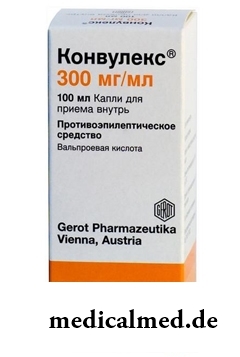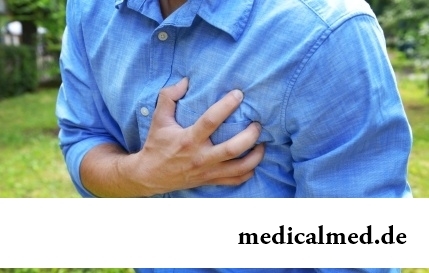





Convulexum
Application instruction:
 Convulexum – anticonvulsant medicine.
Convulexum – anticonvulsant medicine.
Form of release and structure
- Drops for intake: transparent, colourless or slightly yellowish solution (on 100 ml in bottles with the doser, 1 bottle in a cardboard pack);
- Syrup for children: colourless or slightly yellowish liquid with fruit aroma (on 100 ml in bottles of dark glass, complete with the measured syringe, 1 set in a cardboard pack);
- Tablets of the prolonged action, film coated: oval, biconvex, white color, on a break almost white or white, with vanilla aroma, on one of the parties there is a line of a break dividing an engraving (depending on a dosage) "CC|3" – 300 mg, "CC|5" – 500 mg (on 50 pieces, 100 pieces in bottles polypropylene or bottles of dark glass, on 1 bottle in a cardboard pack);
- Capsules are kishechnorastvorimy: gelatinous soft, pink color, covered with a kishechnorastvorimy cover; marking by gray ink specifies a dose – "150", "300" or "500"; contents of capsules – liquid with a characteristic slight smell, colourless or slightly yellowish shade (150 and 500 mg – on 10 pieces in blisters, 10 blisters in a cardboard pack; 300 mg – on 20 pieces in blisters, 5 blisters in a cardboard pack);
- Solution for intravenous (in/in) introductions: transparent liquid, colourless or almost colourless (on 5 ml in ampoules of colourless glass, 5 ampoules in plastic pallets, 1 pallet in a cardboard pack).
Structure of 1 ml of drops for intake:
- Active ingredient: sodium Valproatum – 300 mg;
- Auxiliary components: sodium saccharinate, orange fragrance, Acidum hydrochloricum of 37%, sodium hydroxide, the purified water.
Structure of 1 ml of syrup for children:
- Active ingredient: sodium Valproatum – 50 mg;
- Auxiliary components: мальтитол liquid (ликазин 80/55), sodium cyclomate, sodium saccharinate, sodium chloride, methylparahydroxybenzoate, пропилпарагидроксибензоат, peach fragrance, crimson fragrance, the purified water.
Structure of 1 tablet of the prolonged action, film coated:
- Active ingredient: sodium Valproatum – 300 or 500 mg;
- Auxiliary components: citric acid, eudragit RS30D, ethyl cellulose, talc, magnesium stearate, colloid silicon dioxide;
- Film cover: eudragit RS30D, type A, triethyl citrate, titanium dioxide, a karmelloza of sodium, talc, vanillin eudragit RL30D.
Structure of 1 capsule kishechnorastvorimy:
- Active ingredient: valproic acid – 150, 300 or 500 mg;
- Auxiliary components of a body of the capsule: глицерол 85%, gelatin, Karionum 83, titanium dioxide, Acidum hydrochloricum of 25%, iron oxide red (E172);
- Kishechnorastvorimy cover: polysorbate-80, sodium lauryl sulfate, triethyl citrate, glyceryl monostearate 45-55 type II, macrogoal 6000;
- Ink for marking of the capsule: shellac of 47,5%, dye black iron oxide, titanium dioxide, butanol, propylene glycol, isopropanol, denatured ethanol (metilirovanny alcohol), water.
Structure of 1 ml of solution for in/in introductions:
- Active ingredient: Valproatum sodium/valproic acid – 100 mg / 86,78 mg (1 ampoule – 500 mg / 433,9 mg);
- Auxiliary components: dodecahydrate dinatrium hydrophosphate, sodium hydroxide, the distilled water.
Indications to use
Syrup for children
- Epileptic seizures (including partial, generalized and attacks owing to organic diseases of a brain);
- Epilepsy of any origin;
- The behavioural frustration connected with epilepsy;
- Febrile spasms;
- The Bipolar Affective Disorder (BAD) which is not giving in to therapy by lithium or other anticonvulsant drugs.
Capsules are kishechnorastvorimy, tablets of the prolonged action, drops for intake, solution for in/in introductions
- Epilepsy of various genesis (cryptogenic, idiopathic, symptomatic);
- Partial epileptic seizures at children and adults (with secondary generalization or without it);
- Generalized epileptic seizures at children and adults (tonic, clonic, toniko-clonic, myoclonic, atonic, absentias epileptica);
- Specific syndromes (Lennox-Gasto, Vest);
- The behavioural frustration caused by epilepsy;
- Febrile spasms, children's tic;
- Therapy and prevention of BARS; for tablets of the prolonged action – therapy and prevention of the BARS which are not giving in to treatment by lithium or other anticonvulsant drugs.
Contraindications
Absolute:
- The expressed thrombocytopenia;
- Hemorrhagic diathesis;
- Dysfunctions of a pancreas;
- Liver failure;
- Porphyria;
- Chronic and acute hepatitis;
- Combination with the St. John's Wort which is made a hole lamotridzhiny, meflokhiny (except syrup for children);
- Urea exchange disturbances, including data in the family anamnesis (except syrup for children);
- Body weight at children less than 20 kg (a tablet of the prolonged action);
- Body weight at children less than 7,5 kg (drops for intake);
- Period of breastfeeding (lactation);
- The I trimester of pregnancy (syrup for children);
- Age up to 3 years (a tablet of the prolonged action and the capsule);
- Hypersensitivity to valproic acid and its salts or other components of Convulexum.
Relative (to take with caution in connection with the increased probability of side effects):
- Anamnestic data on diseases of a pancreas and liver, including data in the family anamnesis;
- Oppression of a marrowy hemopoiesis (thrombocytopenia, leukopenia, anemia);
- Renal failure;
- Inborn fermentopatiya (enzymopathies);
- Organic diseases of a brain;
- Hypoproteinemia;
- Pregnancy, especially in the I trimester (except syrup for children);
- Mental retardation at children;
- Body weight at children from 7,5 kg and more (drops for intake);
- Therapy at children several antiepileptic means (solution);
- Multiple associated diseases and severe forms of attacks at children and teenagers (solution);
- Age up to 3 years (solution).
Route of administration and dosage
Capsules are kishechnorastvorimy, tablets of the prolonged action, drops for intake, syrup for children (peroral forms of drug)
Capsules and a pill take inside, during food or right after meal, without chewing, washing down with a small amount of water. Dosing mode: capsules – 2-3 times a day; tablets – 1-2 times a day.
Drops accept inside, washing down with a small amount of water, irrespective of meal. The dosing mode – 2-3 times a day.
Syrup is accepted inside with a small amount of liquid, irrespective of meal. The daily dose of drug is divided into 2-3 receptions.
Initial dose of valproic acid for adults – 600 mg/days, further gradually raise it each 3 days on 150-250 mg to disappearance of attacks (achievement of clinical effect).
At monotherapy an initial dose – 5-15 mg/kg/days, further gradually raise it on 5-10 mg/kg a week.
The recommended daily dose – 20-25 mg/kg (about 1000-2000 mg). In case of need the dose can be increased to maximum – 30 mg/kg (2500 mg).
The maximum daily dose – 30 mg/kg/days, but patients with the accelerated metabolism of valproic acid can increase it to 60 mg/kg/days (on condition of control in a blood plasma of concentration of valproic acid).
For a combination therapy the dose – 10-30 mg/kg/days with increase further on 5-10 mg/kg a week is recommended.
The average daily dose of 15-45 mg/kg, maximum – 50 mg/kg is recommended to children with the body weight of 7,5-25 kg for monotherapy. As a part of complex therapy – 30-100 mg/kg a day.
More than 25 kg are recommended to children with body weight an initial daily dose of 5-15 mg/kg (about 300 mg), with increase further on 5-10 mg/kg a week before disappearance of attacks (achievement of clinical effect), at the same time the dose, as a rule, makes 20-30 mg/kg (1000-1500 mg).
It is necessary to consider that at children with body weight to 20 kg it is not recommended to use drug in the form of tablets of the prolonged action, they should be replaced with other forms of Convulexum.
The recommended average daily doses of drug in capsules, depending on the mass of the patient:
- 7,5-14 kg – 150-450 mg/days: 1-3 capsules on 150 mg;
- 14-21 kg – 300-600 mg/days: 2-4 capsules on 150 mg or 1-2 – on 300 mg;
- 21-32 kg – 600-900 mg/days: 4-6 capsules on 150 mg or 2-3 – on 300 mg;
- 32-50 kg – 900-1500 mg/days: 3-5 capsules on 300 mg or 2-3 – on 500 mg;
- 50-90 kg – 1500-2500 mg/days: 3-5 capsules on 500 mg.
The recommended average daily doses of drug in the form of drops for intake, depending on the mass of the patient:
- 7,5-14 kg – 150-450 mg (15-45 drops);
- 14-21 kg – 300-600 mg (30-60 drops);
- 21-32 kg – 600-900 mg (60-90 drops);
- 32-50 kg – 900-1500 mg (90-150 drops);
- 50-90 kg – 1500-2500 mg (150-250 drops).
Average daily doses of syrup for children Convulexum, depending on the mass of the child:
- 7,5-14 kg – 150-450 mg (3-9 ml);
- 14-21 kg – 300-600 mg (6-12 ml);
- 21-32 kg – 600-900 mg (12-18 ml).
Solution for in/in introductions
The drug is administered infusionally or intravenously slowly.
The recommended daily dose:
- Intravenously – 5-10 mg/kg;
- Infusionally – 0,5-1 mg/kg.
Doses of drug do not change upon transition from peroral forms on in/in introduction. After the last intake, in/in introduction it is recommended later 12 h. Further in/in maintaining it is replaced with administration of drug inside as soon as the condition of the patient allows, it is also necessary to sustain an interval of 12 h from the last in/in uses before the first intake.
The recommended dosing mode for bystry achievement and maintenance of high concentration of valproic acid in plasma: to administer the drug intravenously in a dose of 15 mg/kg within 5 minutes, later 0,5 h to begin infusion with a speed of 1 mg/kg/h (at the same time it is necessary to conduct constant observation of concentration of level of drug in plasma before achievement of value about 75 mkg/ml).
Average daily doses of solution depending on age category:
- Adult, including elderly patients – 20 mg/kg;
- Teenagers – 25 mg/kg;
- Children – 30 mg/kg.
The maximum daily dose – 2500 mg.
For cultivation it is allowed to use 5% glucose solution, isotonic solution of sodium chloride, Ringer's solution. The prepared solution for infusion should be used within 1 days, and unused volume – to destroy. In case of simultaneous it is necessary to enter into uses of other drugs, Convulexum on separate system of injection.
It is reasonable to elderly patients to select more carefully a drug dose, taking into account possible use of reduced doses.
At a renal failure, perhaps, it will be required to lower a drug dose, selecting it by results of observations of a clinical state since data on concentration of valproic acid in plasma can be insufficiently informative.
Side effects
At observance of the recommended dosing mode valproic acid in general by patients is transferred well.
The side reactions from bodies and systems which are preferential arising when Convulexum level in plasma exceeds 100 mg/l, or in case of use of drug as a part of complex therapy:
- Alimentary system: gastralgia, nausea, vomiting, anorexia or bulimia, hepatitis, diarrhea; seldom – a konstipation (lock), pancreatitis;
- Central Nervous System (CNS): a diplopia, a tremor, flashing of "front sights" before eyes, a nystagmus; seldom – changes of mood, behavior or a mental state (feeling of fatigue, a depression, hallucinations, a hyperactive state, aggression, psychoses, motive concern, unusual excitement, irritability), dizziness, drowsiness, an ataxy, a headache, a stupor, a dysarthtia, disturbance of consciousness, a lump;
- System of a hemopoiesis: a leukopenia, thrombocytopenia, anemia, the decrease in aggregation of thrombocytes, contents of fibrinogen and coagulability of blood which is followed by petekhialny hemorrhages, lengthening of a bleeding time, bruises, bleeding, hematomas;
- Metabolism: increase or degrowth of a body;
- Endocrine system: secondary amenorrhea, galactorrhoea, dysmenorrhea, increase in mammary glands;
- Laboratory indicators: giperkreatininemiya, hyperbilirubinemia, giperammoniyemiya, slight dozozavisimy increase of activity of alaninaminotranspherase (ALT), aspartate aminotransferase (nuclear heating plant) and lactate dehydrogenase (LDG);
- Allergic answers: urticaria, skin rash, Quincke's disease, Stephens-Johnson's syndrome, photosensitization;
- Another: hypostases, a hair loss (usually after cancellation of Convulexum hair are recovered).
Special instructions
Because of the available data about heavy (inclusive lethal) episodes of pancreatitis and liver failure, at use of valproic acid it is necessary to consider such facts:
- Group of the increased risk – children from the birth and up to 3 years with heavy epilepsy (it is frequent owing to injury of a brain) and inborn degenerative or metabolic pathologies;
- Functional disturbances of a liver preferential develop in the first 0,5 years of treatment (usually from 2 to 12 week), is more often when using drug as a part of complex therapy;
- Cases of pancreatitis are observed irrespective of age of the patient and duration of a course of therapy, but the risk of a course of a disease with increase in age of the patient decreases;
- The probability of a lethal outcome increases with insufficiency of function of a liver;
- Diagnosis on early (to icteric) stages is based preferential on results of clinical observations and consists in identification of precursory symptoms, such as anorexia, an adynamy, drowsiness, extreme fatigue, sometimes against the background of vomiting and abdominal pains; besides, at invariable antiepileptic therapy the recurrence of epileptic seizures can be observed.
In any of such cases it is necessary to see immediately a doctor for carrying out clinical inspection and the analysis of function of a liver.
During therapy, especially in the first half a year, it is necessary to control function of a liver periodically: activity of ALT and nuclear heating plant, concentration of bilirubin, level of fibrinogen, a prothrombin, coagulation factors, and also activity of amylase (each 3 months, especially at therapy by valproic acid in a combination with other antiepileptic drugs) and a picture of peripheral blood, including thrombocytes.
To the patients receiving other antiepileptic substances / drugs, it is necessary to carry out transfer into valproic acid gradually, reaching clinically effective dose within 2 weeks, gradual cancellation of the drugs accepted earlier is admissible after that. If Convulexum is the first antiepileptic drug accepted by the patient, then clinically effective dose should be reached in 1 week.
The probability of development of side reactions from a liver is increased at children, and also when performing the combined anticonvulsant treatment.
Along with valproic acid it is impossible to take the drinks containing ethanol.
Before operation it is necessary to make the general blood test, including definition of number of thrombocytes, indicators of a koagulogramma, bleeding time.
If during treatment there is a symptom complex "acute abdomen", to surgical intervention it is necessary to define activity in amylase blood to exclude acute pancreatitis.
During therapy it is necessary to consider probability of distortion of results of analyses of urine at a diabetes mellitus (because of increase in maintenance of ketonic bodies) and indicators of function of a thyroid gland.
In case of development of any serious acute side reactions it is necessary to discuss immediately with the attending physician expediency of the termination or continuation of a course.
To reduce risk of development of dispeptic frustration it is recommended to accept spasmolysants and the enveloping medicines.
Sharp phase-out of valproic acid is capable to provoke increase of epileptic seizures.
Women of reproductive age at therapy have to apply reliable contraceptives as during pilot studies it is established that Convulexum has teratogenic effect.
It is necessary to be careful, managing motor transport and being engaged in potentially dangerous types of activity demanding speed of psychomotor reactions and the increased concentration of attention.
Medicinal interaction
Are contraindicated:
- Meflokhin: strengthens valproic acid metabolism, reduces its concentration in plasma; at the same time the anticonvulsant effect of a meflokhin decreases (the similar combination leads to increase in risk of epileptic seizures);
- St. John's Wort made a hole (ordinary): there is a probability of decrease in a blood plasma of concentration of valproic acid.
Demand extra care:
- Zidovudine: concentration in plasma increases owing to what its toxicity increases;
- Carbamazepine: concentration of its active metabolite in plasma to overdose symptoms increases; concentration of valproic acid decreases and her hepatic metabolism amplifies (observation of the doctor, including behind concentration of drugs in plasma, perhaps is recommended, correction of doses will be required);
- Karbapenema, monobaktama (panipeny, meropeny, to aztreona, imipeny): reduce concentration level in valproic acid plasma, decrease in anticonvulsant action of Convulexum is possible;
- Clonazepam: in isolated cases strengthening of expressiveness of the absansny status is possible;
- Neuroleptics, antidepressants, monoamine oxidase inhibitors (MAO), benzodiazepines: efficiency of Convulexum decreases, effect of these psychotropic drugs and benzodiazepines is at the same time exponentiated;
- Primidonum, phenobarbital: their concentration in plasma to overdose symptoms increases (preferential at children), hepatic metabolism of valproic acid amplifies, its concentration in plasma decreases (the first 2 weeks of complex therapy definition of concentration in blood of level of antikonvulsant and clinical observation is required; in case of signs of sedation it is necessary to reduce immediately doses of Primidonum or phenobarbital);
- Topiramat: the probability of development of encephalopathy and a giperammoniyemiya increases;
- Felbamat: for 35-50% increases concentration of valproic acid in plasma, there is a danger of overdose (clinical observation and determination of level of concentration of valproic acid in blood, change of its dose at a combination is required with felbamaty, and at its cancellation);
- Phenytoinum: change of its concentration in plasma, and also decrease in concentration of valproic acid and strengthening of her hepatic metabolism is probable (determination of level of concentration of antiepileptic substances in blood, clinical observation and, if necessary, change of doses is recommended);
- Erythromycin, Cimetidinum: hepatic metabolism of valproic acid is suppressed, its concentration in plasma increases;
- Ethosuximidum: owing to metabolism change its concentration in blood serum can both increase, and to decrease (determination of level of concentration of antiepileptic substances in blood, clinical observation and, if necessary, correction of doses is necessary).
It is necessary to take into account:
- Acetylsalicylic acid: strengthens effects of valproic acid as a result of replacement it from communication with proteins of plasma; mutually effect of acetylsalicylic acid amplifies;
- Miyelotoksichny drugs: the probability of oppression of a marrowy hemopoiesis increases;
- Indirect anticoagulants: their action amplifies, it is required to control carefully the size of a prothrombin ratio at the combined use about vitamin K-dependent anticoagulants;
- Nimodipin: hypotensive action as valproic acid, suppressing metabolism, increases its concentration in plasma amplifies;
- Gepatotoksichny means, ethanol: the risk of development of damages of a liver increases.
Others:
- Oral contraceptives: Convulexum, without causing induction of microsomal enzymes of a liver, does not reduce efficiency of hormonal peroral contraceptives;
- Lamotridzhin: increases risk of heavy allergic skin reactions, such as a toxic epidermal necrolysis (this combination of drugs is not recommended, however if it is necessary, careful laboratory and clinical control is required).
Terms and storage conditions
To store in the place unavailable to children:
- Tablets, solution, syrup, drops – at a temperature up to 25 °C;
- Capsules – to 30 °C.
Period of validity – 5 years.
Name of drug
Price
Drugstore
Convulexum syrup for children 50mg/ml фл 100 ml, Gerot Pharm./Scherer GmbH
137 rub.
 Network of the Moscow drugstores of IFC
Network of the Moscow drugstores of IFCDrop Convulexum 300mg/ml фл 100 ml, Gerot Pharm./Scherer GmbH
209 rub.
 Network of the Moscow drugstores of IFC
Network of the Moscow drugstores of IFCConvulexum тбл п / about ретард 300 mg No. 50, Gerot Pharm./Scherer GmbH
339 rub.
 Network of the Moscow drugstores of IFC
Network of the Moscow drugstores of IFCConvulexum тбл п / about ретард 500 mg No. 50, Gerot Pharm./Scherer GmbH
558 rub.
 Network of the Moscow drugstores of IFC
Network of the Moscow drugstores of IFCThe first vibrator was invented in the 19th century. It worked at the steam engine and intended for treatment of female hysteria.

The thought that the mass of their body is too big at least once in life visits from 80 to 95% of women. Many...
Section: Articles about health
Sooner or later hair turn gray at all. Many people try to hide these changes, returning natural color of the hair by means of coloring, or considerably changing it for the purpose of creation of absolutely new image. All know that the gray hair is a sign приближающ...
Section: Articles about health
The depression not without reason is considered one their main troubles of our century: for scientific and technical progress, acceleration of rate of life and a surplus of information of people it is forced to pay with stresses, negative emotions and weakening of protective forces of an organism. As a result widely the states which are characterized by the increased uneasiness, falling of interest in life, spiritual and physical discomfort extend....
Section: Articles about health
Physical activity is necessary for normal functioning of a human body. At a lack of the movement cease функц...
Section: Articles about health
At this plant there are a lot of names: tuberiferous sunflower, Jerusalem artichoke, solar root, earth pear. Contrary to popular belief, it is not an exotic plant at all. The wild girasol grows in a midland of Russia practically everywhere: at the edges of roads...
Section: Articles about health
For many spouses the question of planning of a family is one of the main. The problem of the choice of effective and safe contraceptives at the same time comes out on top. Russians still not often resort to operation of a vasectomy extremely popular in the USA, and also in some European and Asian countries. The reason is simple: most of men simply do not possess the complete information about specifics and effects of this procedure. Let's try to meet this lack and to acquaint readers about those...
Section: Articles about health
Dogrose – one of the most widespread adornment and medicinal plants growing practically in all territory ours...
Section: Articles about health
Very often as a source of the infection which caused a disease serves our house - the place which a priori has to be safe. However disease-producing bacteria can perfectly feel not only in insanitary conditions, but also in our apartment if not осущ...
Section: Articles about health
Doctors claim that the people not so familiar with a dorsodynia occur among adult Russians very seldom. At the same time the vast majority of the patients who are periodically testing this indisposition do not hurry to ask for medical care at all. On the one hand, there is an opinion that feelings of this sort at mature age are nearly natural phenomenon which is not doing serious harm to health. With another – practice of self-treatment various obezbol is eurysynusic...
Section: Articles about health
Dietary supplements (dietary supplements) for the last decades were so thoroughly included into our life that, apparently, it is already impossible on...
Section: Articles about health
Life of the modern child is extremely active and difficult. Information strain which is experienced by the school student and did not dream pupils of last times. Careful parents, wishing well to the children, will organize a set of additional classes in circles, sports...
Section: Articles about health
There comes the season of issues. Many Russians already dream of outdoor recreation, trips, beautiful seaside beaches. At this time there is no wish to think of problems with health and other unpleasant things, however there are subjects which require attention. In the summer repeatedly the risk increases to ache with some very dangerous illnesses, we also will talk about them today....
Section: Articles about health
Eyes – one of the most vulnerable areas on a face therefore age changes concern them first of all. Whether it is possible to keep a pier...
Section: Articles about health
Scientists always aimed to offer fundamental explanations for medical problems. Their theories formed the basis of modern methods of treatment of the hardest pathologies and helped to save a set of lives. However stories are known also such theoretical constructions, following to...
Section: Articles about health
So, you resolved to lose weight. And now you try to understand what to begin with: from exercise stresses or a diet? And how to make that process of weight loss did not give you an inconvenience, and, on the contrary, brought joy?...
Section: Slideshow
The popular expression "run from a heart attack" became the motto of the people supporting active lifestyle. Moreover, run became peculiar...
Section: Articles about health
Dark circles (bruises) under eyes – a shortcoming with most of which often fight against the help of cosmetics (proofreaders, saloon procedures and so forth), eliminating only its visibility. However, according to doctors, skin around eyes – the indicator of many disturbances in an organism...
Section: Articles about health
Each person knows that fervescence is an illness sign. However too low temperature (hypothermia), especially also can demonstrate existence of diseases when it is observed long enough. Such state is dangerous that it, unlike fever, does not give a serious inconvenience: patients usually complain only of weakness, drowsiness, apathy. Sometimes the fever and a cryesthesia in extremities joins. Many people at similar symptoms...
Section: Articles about health
The state of health of the person depends on many factors. One of the most important is the constant but which is not exhausting, motive...
Section: Articles about health
From sexual contacts each person can test insufficiently strongly expressed sexual desire or lack of satisfaction from time to time. However when it happens regularly, it is an occasion to think about health. Most of people does not hurry an obrashcha...
Section: Articles about health
Extracorporal fertilization – one of the most modern methods of controlling with infertility. So far he already helped a significant amount of married couples to become happy parents. Usually to the EKO procedure difficult and very expensive, resort in those situations when all other ways to help couple to bring the child are inefficient. "Conception in a test tube" yields quite good results in cases of infertility of one of partners, existence at the woman of impassability of uterine tubes...
Section: Articles about health
Cold is such painful that each sigh becomes a victory, heat "knocks" down, and the ache in joints forces to think only about...
Section: Articles about health
The naturopathy sometimes moves as the new direction of medicine, something like fashionable hobby, and there is nothing farther from the truth. This most ancient direction, the word "naturopathy" is translated as "treatment by the nature", and, no doubt, treatment приро...
Section: Articles about health
For the time being the perspective of heart diseases seems to most of people remote and foggy. But sooner or later practically each adult faces extremely unpleasant feelings: sudden stethalgia. To be consoled at this time in a thought of what for a heart attack still early, will hardly turn out: if the person is impressionable, he, as a rule, has feeling of panic and fear of fast death. And meanwhile, it is very often possible to confuse pains with cardiac pains невралгическог...
Section: Articles about health
Iodine - one of thirty most important microelements in our organism. The main role of iodine consists in synthesis thyroid гормо...
Section: Articles about health
Color of plants is caused by presence at them of certain chemical compounds. Let's talk about what is meant by various colors of vegetables and fruit and what properties they give them....
Section: Articles about health
Aging — natural and inevitable process. Over time our skin loses elasticity, on it saggings are formed, the face form loses former clearness. The procedure of nitevy lifting (nitevy tightening) can successfully solve this problem. In order that it is better to get acquainted with this popular procedure, we will tell you 6 cognitive facts about it....
Section: Articles about health

